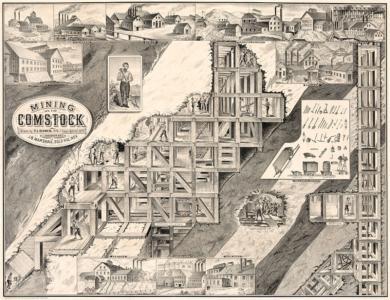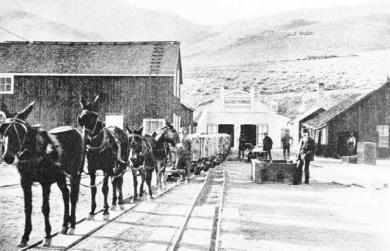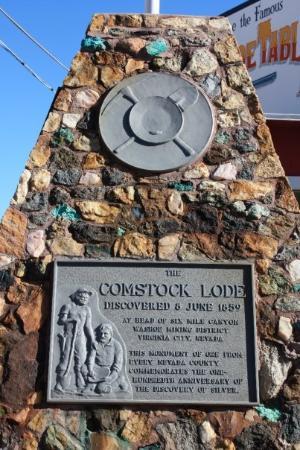 SKC Films Library |
| SKC Films Library >> Ore Deposits and Mining |
| Comstock Lode the first major silver discovery in the United States The Finds Gold was first discovered in the area around present-day Virginia City, Nevada, by Mormon emigrants on their way to the California gold fields in 1850. The gold deposits did not appear particularly rich, however, and most of the emigrants continued on to California. The few prospectors who stayed behind were gradually joined by others, and by the spring of 1853 there were about 200 in the area. Although most of the prospectors were successful at finding traces of gold in the streams and rivers of the area, none reported finding the "mother lode." location of Virginia City In the fall of 1857, brothers Ethan Allen and Hosea Ballou Grosh reportedly found a deposit of gold and silver ore somewhere in the vicinity of what is now known as the Comstock Lode. Both brothers died before they could file a claim, however, and their possessions were "assumed" by Henry Tompkins Paige Comstock the following year. Comstock knew that the brothers had discovered a significant deposit and immediately set out to find it, but was unsuccessful. In January of 1859, James "Old Virginny" Finney, John "Big French John" Bishop, Aleck Henderson, and Jack Yount discovered a vein of gold now known as the Gold Hill Outcropping. While this vein is not part of the main Comstock Lode, it is now believed to have been the one first discovered by the Grosh Brothers. In June of 1859, prospectors Peter O'Riley and Patrick McLaughlin were about to give up their claim at the head of Six-Mile Canyon when they decided to make one last attempt to find gold, this time by digging. They found "pay dirt," but Henry Comstock claimed that the find was made on his land and convinced the men to make him a partner. The men continued to find some gold, but the bluish clay that kept clogging their equipment proved to be the true "mother lode," as it turned out to contain silver of exceptional purity. This discovery, now known as the Ophir Claim, triggered a rush of thousands of miners to the area. By the mid-1870's, Virginia City, which literally grew on top of the "mother lode," had a population of 25,000. Virginia City at the height of the Comstock Lode Fates of the Finders The men who discovered the silver lodes knew from the start that they lacked the expertise and money to exploit them, and therefore barely thought twice when investors began buying up claims and shares of claims. Patrick McLaughlin sold his 1/6 interest in the Ophir Claim for $3,000 to George Hearst, father of media mogul William Randolph Hearst. McLaughlin soon lost the money, and died working odd jobs in California. Emanuel Penrod, partner to Henry Comstock, sold his share of the Ophir Claim for $5,500, and his half interest in the adjacent "Spanish Claim" for $3,000. Peter O'Riley held on to his Ophir interests, collecting dividends, until selling for about $40,000. He erected a stone hotel on B Street in Virginia City called the Virginia House, and became a dealer of mining stocks. He eventually lost everything, however, was declared insane, and died in a private asylum in Woodbridge, California. Henry Comstock eventually sold all of his Ophir holdings to Judge James Walsh for $11,000, and half of the "Spanish" mine for $5,500. He used the money to open trade good stores in Carson City and Silver City, but ended up going broke. After losing nearly all his property and possessions in Nevada, he prospected for some years in Idaho and Montana without success. In September 1870, while prospecting in Big Horn country, near Bozeman, Montana, he committed suicide with his revolver. Technological Innovations Developing the Comstock Lode represented a major achievement of applying ideas and inventions of the Industrial Revolution to the age-old practice of mining. This was necessary due to the nature of the ore deposits, buried as they were deep underground, and because Virginia City and Gold Hill were built in an arid region, far from necessary resources on the steep hillside of Mount Davidson. The ore also ran deeply underground. Consequently, grappling with these difficulties required a totally new technology. By 1880, Virginia City's mines were as deep as 2,100 feet below ground level, deeper than any mines anywhere up to that time. To keep the soft soil from collapsing upon the miners, Comstock mines relied on square set timbering, a shoring method invented by Philip Deidesheimer. As ore was removed it was replaced by timbers set as a cube six feet on a side. Thus, the ore body would be progressively replaced with a timber lattice. Often these voids would be re-filled with waste rock from other diggings after ore removal was complete. By this method of building up squares of framed timbers, an ore vein of any width could be safely worked to any height or depth. depiction of the shoring system used in Comstock
mines Early in the history of Comstock mining, there were heavy flows of water to contend with. This called for pumping machinery and apparatus, and as greater depth was attained, larger pumps were demanded. All the inventive genius of the Pacific Coast was called into play, and this resulted in construction of some of the most powerful and effective steam and hydraulic pumping equipment to be found anywhere in the world. As exploitation of the Comstock Lode increased, so too did the need for supplies. Through the 1860's everything the miners needed was brought in on the backs of mules, and the silver and gold recovered from the mines left the area the same way. In February of 1869 a group of San Francisco-based investors began construction of the Virginia and Truckee Railway, which reached Carson City in January of 1870. When silver was first discovered on the Comstock, the flow of water from natural springs was adequate to supply the needs of the miners and small towns of Virginia City and Gold Hill, Nevada. Those springs quickly became inadequate, however, and by the end of 1860's it was obvious that an "outside" source had to be found. Hermann Schussler solved the Comstock's water supply shortage by designing and overseeing construction of a system of pipes that delivered water from the Sierra Mountains into Virginia City, a distance of about twenty miles. While there was a scarcity of water on the surface, there was an excess of water underground in all the mines. Floods in the mines were sudden and miners narrowly escaped being drowned by vast underground reservoirs that were unexpectedly tapped. To overcome these troubles, Adolph Sutro conceived the idea of running a drain tunnel under the Comstock Lode from the lowest possible point. The tunnel was 9.5 feet wide and 7.5 feet high, inside of the timbering. Drain flumes were sunk in the floor, and over these were two tracks for horse carts. The tunnel provided drainage and ventilation for the mines, as well as gravity-assisted ore removal. However, by the time the tunnel reached the Comstock area mines, most of the ore above 1,650 feet had already been removed and the lower workings were 1,500 feet deeper still. Although virtually no ore was removed through the tunnel, the drainage it provided greatly decreased the operating costs of the mines served. Legacies of the Lode Virginia City was the most important city between Chicago and the Pacific in the 1870's. The population soared from 4,000 in 1862 to 25,000 in 1874. The town's six-story hotel had the only elevator west of Chicago, and downtown had 110 saloons, several opium dens, and 20 theaters and music halls. Largely because of Virginia City's population boom, Nevada Territory was created in 1861 and statehood came just three years later. Virginia City's population began to decline in 1877, however, and by 1930 only 500 people still lived in the town. From 1859 until 1882, the official amount taken out of the Comstock was $305,779,612.48, but the vast majority of the companies did not prove profitable for the owners. Stockholders received dividends of $115,871,100, but out of 103 mining companies reporting, only fourteen were responsible for this payout. Against that, 102 companies assessed $61,715,535 from shareholders, leaving a net of only $54,155,565 remaining to stockholders. Of the 103 companies, only six ever paid more dividends than they demanded in assessments, and 97 never paid a dividend at all. After 1878, the bonanza discoveries rather rapidly petered out, and, although the Comstock was to produce ore until the 1940's, it was at a greatly reduced rate. Few Comstock miners stayed in Nevada after the mines played out. With a total population of perhaps 25,000 people at its height, Storey County, which encompassed the Comstock, by 1900 had only 3,560 souls. From 1880 to 1900 the state lost a third of its people Comstock Lode Memorial in Virginia City
SOURCES |
| SKC Films Library >> Ore Deposits and Mining This page was last updated on June 20, 2018. |


